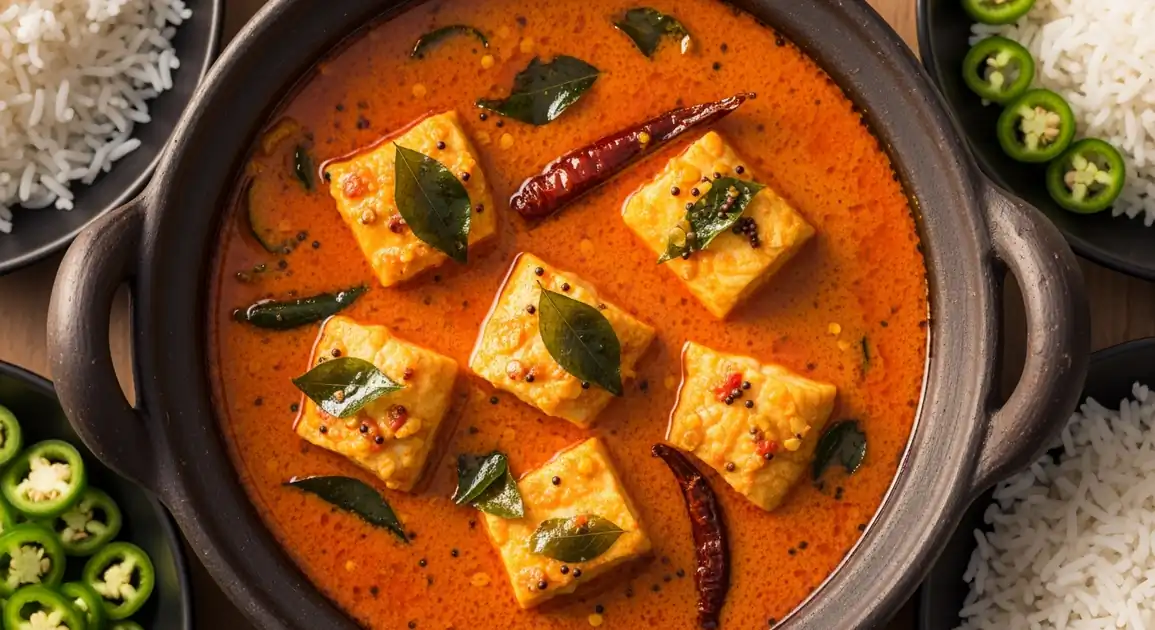Sri Lankan Fish Curry
මාළු කිරිබත් (Malu Kirihodi)

Description
Fish curry is ubiquitous throughout Sri Lanka but shows regional variations. The coastal areas, particularly the south and west, are known for coconut-rich versions while northern preparations tend to be spicier and more sour. As an island nation, Sri Lanka's fish curry reflects its deep cultural connection to the sea, appearing at all meals from breakfast to dinner.
Dietary Information
Serving information
Serving style
Traditionally served in clay pots or small metal dishes alongside rice on a banana leaf or plate. At more casual establishments, it may come as part of a 'rice and curry' set with several other curries and sides.
Quick facts
Rice and curry places typically serve from 11 AM - 3 PM for lunch and 6 PM - 10 PM for dinner. Some casual eateries may have fish curry available throughout the day.
Safety Tips
What to Look For
-
Clear broth with natural oil separation on top
A thin layer of natural orange-red oil from coconut milk indicates proper cooking and prevents spoilage.
-
Fish pieces that hold their shape and are opaque white/pink
Properly cooked fish should be firm and fully opaque, never translucent in the center.
-
Aromatic fragrance with distinct curry leaf and spice notes
Fresh curry should have a complex aroma dominated by curry leaves, coconut, and warming spices, not a fishy smell.
-
Made to order or in small visible batches
Especially important in casual eateries; fish curry shouldn't sit for hours at room temperature.
What to avoid
-
Grayish or excessively broken fish pieces
Indicates old or repeatedly reheated fish, potential for bacterial growth.
-
Overly cloudy or curdled coconut milk base
Suggests the curry has spoiled or the coconut milk has fermented due to prolonged heat exposure.
-
Strong fishy or ammonia-like smell
Indicates the fish wasn't fresh when cooked or the curry has spoiled.
-
Unnaturally bright red or orange color
May indicate excessive coloring agents rather than natural spices.
Price information
Price range
Budget tips
- Local 'kades' (small eateries) offer the most affordable fish curry, typically 150-350 LKR with rice.
- Mid-range restaurants charge 500-800 LKR for a portion.
- Tourist-oriented establishments, especially in beach towns, may charge 800-1200 LKR.
- Lunch packets (rice and curry to go) often include fish curry and are economical at 200-400 LKR.
Value indicators
- Visible fish display showing fresh catch options.
- Specific mention of fish variety used.
- Serving size with substantial pieces of fish, not mostly sauce.
- Proper consistency of coconut milk, neither too watery nor curdled.
- Accompanying rice and side dishes included in price.
Where to Find This Dish
Coastal Towns
Restaurants and casual eateries in fishing communities often serve the freshest versions.
Fish markets, Fishing harbors
Morning, Lunch
Markets and Commercial Areas
'Buth kades' (rice shops) in busy market areas serve pre-made fish curry throughout the day.
Public markets, Bus stations
Lunch
Tourist Areas
Restaurants in areas frequented by visitors often offer milder versions alongside authentic preparations.
Beach resorts, Cultural sites
Lunch, Dinner
Vendor Tips
- Ask about the fish variety used - quality places will specify.
- If you see 'fresh catch' or 'daily fish' mentioned, it's likely a better choice.
- Mid-morning to early afternoon generally offers the freshest preparations.
How to Order
Regional Variations
-
Ambulthiyal (Sour Fish Curry)
(අම්බුල් තියල්)
A drier, more intensely sour curry using goraka as the primary souring agent with minimal or no coconut milk. Often made with tuna.
-
Jaffna-style Fish Curry
(යාපනේ මාළු කිරිය)
Northern-style preparation featuring more chili, less coconut milk, and often includes kokum or tamarind for sourness.
-
White Fish Curry
(සුදු මාළු කිරිය)
A milder variation made without chili powder, using only coconut milk, green chilies, and lighter spices for a pale color.
-
Coconut Milk Fish Curry
(කිරි මාළු හොදි)
Richer version with a higher ratio of thick coconut milk, making it creamier and less spicy.
-
Fish Head Curry
(මාළු ඔලුව කරිය)
Special preparation using just the fish head, prized for its rich flavor and gelatinous texture from the cheeks and eyes.
Cultural context
History
Fish curry has been a staple in Sri Lankan coastal communities for centuries, evolving from the abundant seafood resources surrounding the island. The current version, influenced by Portuguese, Dutch, and indigenous cooking methods, emerged during colonial times when new spices were introduced to the island. In southern coastal areas like Galle, the curry developed a distinctive character using local goraka fruit and fresh coconut, which were plentiful. Historically, it was cooked in clay pots (muthi) over wood fires, which many traditional establishments still do to maintain the authentic smoky flavor.
Local significance
Fish curry represents Sri Lanka's island geography and the centrality of seafood in the national diet. It's considered an essential dish in most households.
Eating customs
- Eaten with rice, mixed with the right hand (though foreigners can use utensils).
- Usually combined with various accompaniments like coconut sambol, pickles, and vegetable curries.
- The curry sauce is considered valuable for moistening the rice, not just the fish pieces.